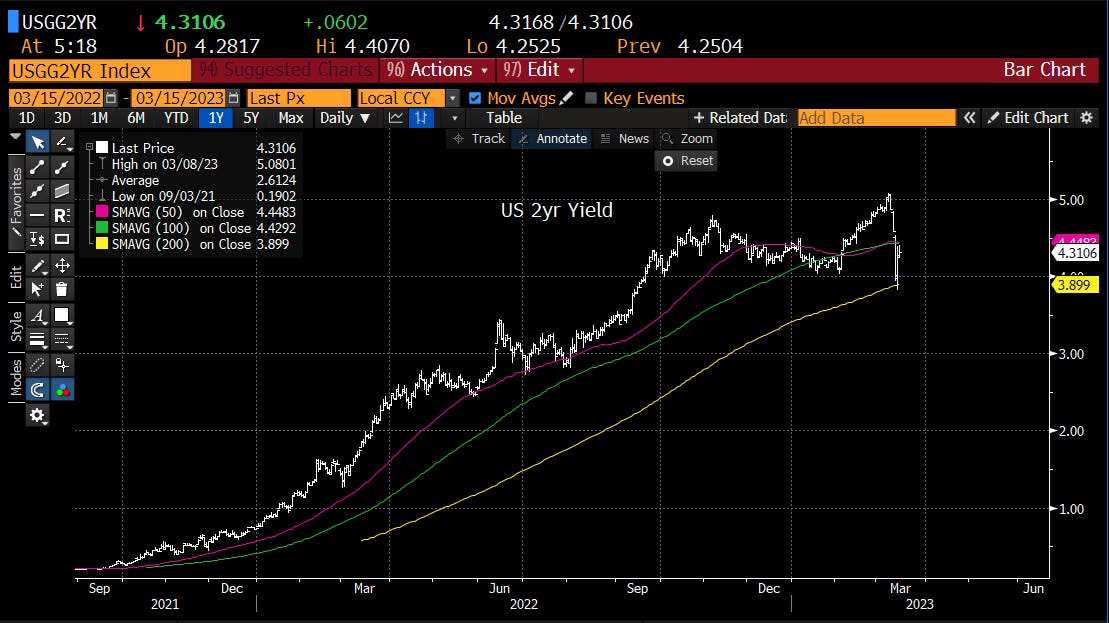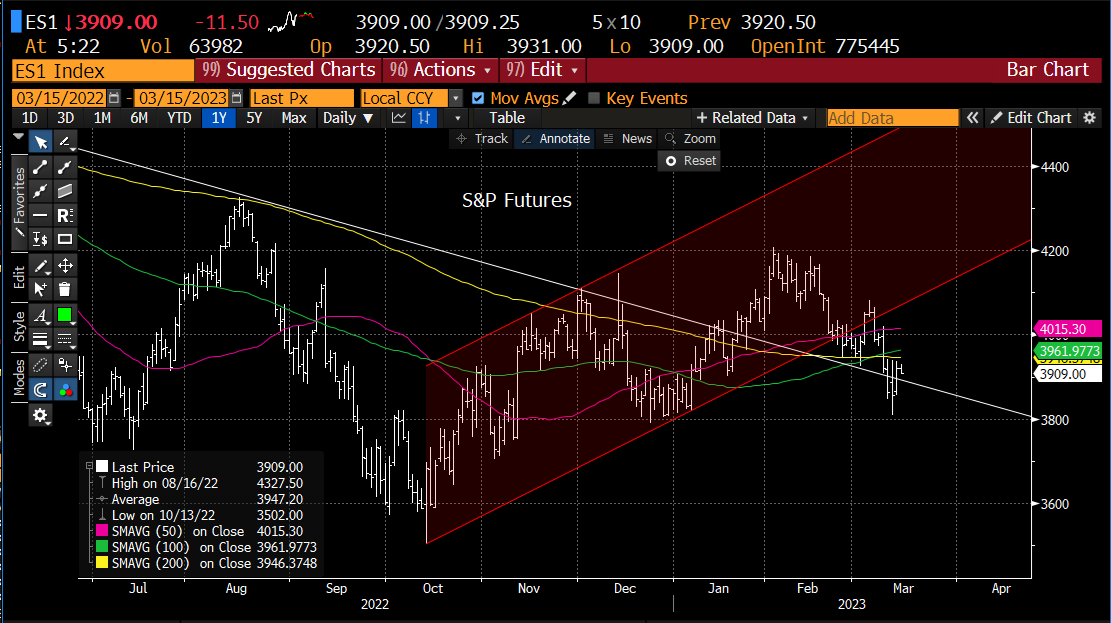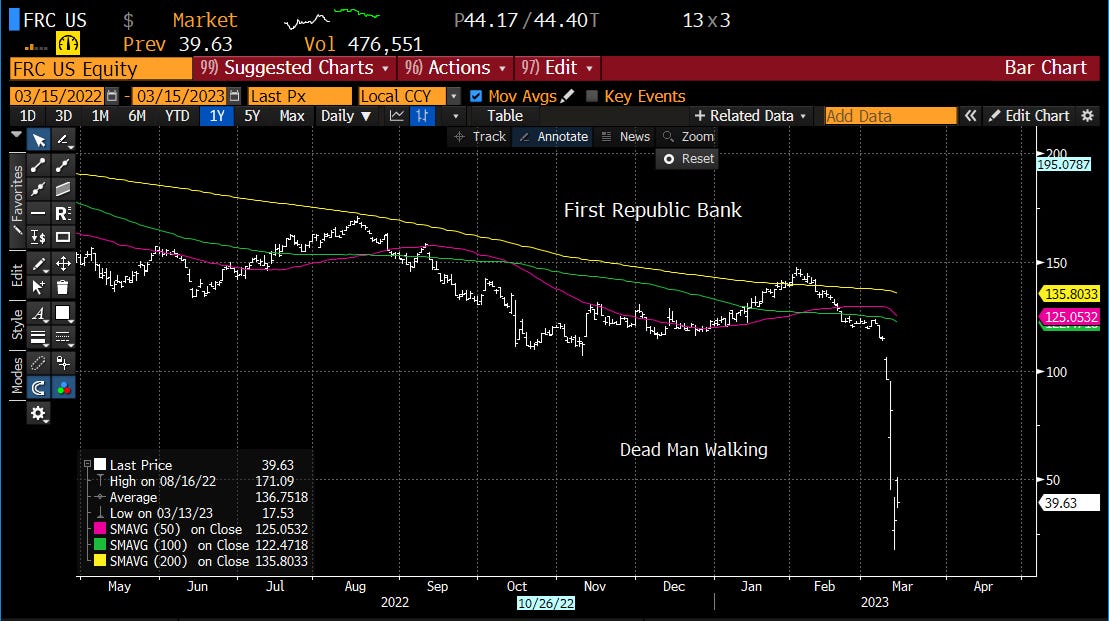MAD Macro - Keep Your Seat Belts Buckled
It Is Not A Bailout, We Killed The Owners
MAD Macro will next publish Thursday, March 23.
When is a bailout not a bailout? When you don’t bailout the stock and bond holders. It’s only been two days but the unintended consequences are already starting to emerge from the fog of war. Obviously, the uninsured depositors are being bailout, so it’s a bailout. In Elizabeth Warren’s mind as long as you kill the owners, the stock and bond holders, it’s not a bailout. It’s all in the eye of the beholder. As always, there will be some unintended consequences of big government intervention. As I said yesterday, I don’t think there were any good options and it needed to be done. Jon Hilsenrath, the old Fed whisperer, has a very good article in today’s WSJ on the bank bailout. In the article, Thomas Hoening, the retired Kansas City Fed governor, makes the obvious point that once you bail out one group of uninsured depositors you will have to bail them all out. By-the way, there is a very good book featuring Thomas Hoening, on all of the Fed’s easy money mistakes. There are 17.6 trillion dollars in the U.S. banking system. Hopefully the uninsured number is much smaller. I noticed that all of the regional banks opened sharply higher yesterday, but finished the day near the lows. Not great trading action.
The Fed can’t bailout the depositors unless they put the bank into receivership and kill all of the owners. So if you are an owner of a regional bank you might want to sell at any price and ask questions later. If you are an uninsured depositor, no worries, but if you don’t want any hassles move your money today to a money center bank. It seems the unintended consequences will arrive very quickly. Someone referred to the Silicon Valley and Signature Bank runs as the Twitter-fueled bank runs. If I was a regional bank owner I would sell and run for the hills. I would not be surprised to see a nationwide run on non-money center banks. Think about it. If the owners sell and the stock falls then the depositors pull and finish the job. Another dead bank. If George Bailey was around today and he knew the government was going to bailout his depositors and take away the bank, he might have jumped from that bridge despite the pleadings of his angel Clarence. Someone should keep an eye on Greg Becker. He might take a walk over the Golden Gate Bridge. Not that Greg Becker is a good guy, selling some of his stock and paying bonuses last Friday was a bad look. He is now entering banking purgatory. The SEC and the DOJ announced investigations into SVB. Additionally, he knows he will be heading to Washington at some point to answer questions from Elizabeth Warren. That will be a very unpleasant experience. Just ask Jay Powell, the “most dangerous man”, what it’s like.
Markets are due to open sharply lower today. We do have important economic news at 8:30 am, PPI and Retail sales. Retail sales will be interesting. It’s supposed to be slightly lower after the very strong January report.
I updated the U.S. dollar index, U.S. 2yr yield, U.S. 10yr yield, S&P futures, NASDAQ 100 futures, KBW bank index, First Republic Bank, bitcoin and spot gold charts below.
Markets are selling off early this morning and the U.S. dollar is slightly higher on a safety trade. If the U.S. needs to bailout all uninsured depositors the dollar should fall sharply.
U.S. 2yr and 10yr interest rates are falling as risk assets decline.
S&P and NASDAQ 100 futures are sharply lower.
I added the KBW bank index and the First Republic Bank charts today. This could be where the selling shows up today.
Bitcoin is lower and gold is unchanged.
IMPORTANT DISCLOSURES AND DEFINITIONS
Unless otherwise stated, Bloomberg is the source of all data and charts.
S&P 500 futures are a type of derivative contract that provides a buyer with an investment priced based on the expectation of the S&P 500 Index’s future value. Nasdaq 100 futures are commodities futures products traded within the equity futures sector. West Texas Intermediate (WTI) oil is a benchmark used by oil markets, representing oil produced in the U.S. Brent Crude Oil is a blend of crude oil recovered from the North Sea in the early 1960s, whose price is used as a benchmark for the commodity's prices. The U.S. dollar index (USDX) is a measure of the value of the U.S. dollar relative to the value of a basket of currencies of the majority of the U.S.'s most significant trading partners. UBS Bloomberg Constant Maturity Commodity Index is a total return rules-based composite benchmark index diversified across commodity components from within specific sectors.
The information herein represents the opinion of the author(s), an employee of the advisor, but not necessarily those of VanEck. The securities/ financial instruments discussed in this material may not be appropriate for all investors. The appropriateness of a particular investment or strategy will depend on an investor’s individual circumstances and objectives.
This material has been prepared for informational purposes only and is not an offer to buy or sell or a solicitation of any offer to buy or sell any security/financial instrument, or to participate in any trading strategy.
Certain statements contained herein may constitute projections, forecasts and other forward looking statements, which do not reflect actual results, are valid as of the date of this communication and subject to change without notice. Information provided by third party sources are believed to be reliable and have not been independently verified for accuracy or completeness and cannot be guaranteed. VanEck does not guarantee the accuracy of third party data.
All investing is subject to risk, including the possible loss of the money you invest. As with any investment strategy, there is no guarantee that investment objectives will be met and investors may lose money. Diversification does not ensure a profit or protect against a loss in a declining market. Past performance is no guarantee of future performance.













